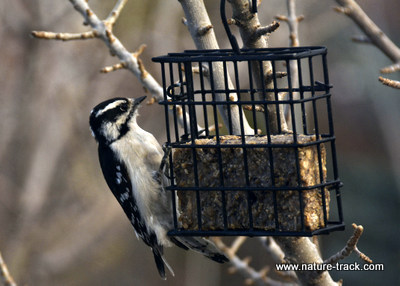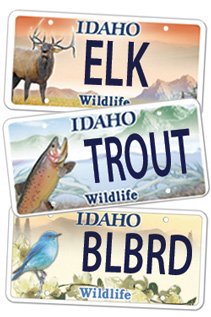Easy Suet Recipe

A downy woodpecker prepares to dine on a newly installed homemade suet block.
I picked up five brochures at the Saguaro National Park Visitor Center. Each one was titled, A Recipe for Inviting…(specific wildlife such as hummingbirds and desert finches) to Your Backyard. I like recipes because if followed, they should produce consistent results. I recognized that recipes for desert dwellers won’t likely work for species in Idaho, but I still like recipes for new ideas. This is mainly because the ones I have tried haven’t worked so well.
Since I built my home 15 years ago, I have tried hard to attract wildlife to my yard with mediocre results to say the least. I get the usual house sparrows, house finches, robins, goldfinches, starlings and magpies, but only occasionally get chickadees, woodpeckers, waxwings or hummingbirds.
I have found a recipe though that does seem to be a favorite for all birds that visit my yard, whether they are regulars or special visitors. It is a homemade suet recipe that I have shared on my website in the past. I will repeat it here.
First a little description of what suet is. Suet is rendered animal fat, specifically from around the kidneys. This is actually kind of hard to find in my experience, so I use the word, suet, more generically. Here, a suet block is indeed made from animal fat but rather than beef or mutton, it is lard from a pig.
Unlike true suet, lard is readily available from the grocery store in the baking isle next to the shortening and cooking oil. The value of either suet or lard is to give birds an excellent source of energy during the cold winter months.
I decided to try making my own suet blocks after watching birds pick unenthusiastically at my commercially prepared suet blocks. From what I had read, birds were supposed to really target suet in the winter but my commercial blocks would last for weeks.
When I decided to try making a suet block, I checked a lot of recipes on the internet. Most had as basic ingredients peanut butter and lard. Beyond that, creativity, not biology ruled. Flour, cornmeal, sunflower seeds, oatmeal, bread crumbs and crackers were all suggested. Most suggested adding sugar, and one required honey (clearly they haven’t priced honey lately). Finally, I settled on this one from Birds and Blooms reader Ethel Fleming of Hemphill, Texas as it seemed to have the most thoughtful ingredients.
Easy Suet Recipe
2 cups peanut butter (I use freshly ground peanuts if I can get them)
2 cups lard
½-1 cup each of flour (I use whole wheat), old-fashioned oats, raw unsalted peanuts, shelled raw sunflower seeds and chopped corn if I have it.
Melt peanut butter and lard together. Be careful to use a low heat as the peanut butter burns very easily. Mix all ingredients in a large cake pan and refrigerate until hardened. Cut and place in suet feeders for your feathered friends.
Note: I used to add raisins to the mix, but the birds didn't seem to like them. It is possible that most fruit-eating birds don't respond well to suet feeders, I don't know. However, these days I leave the raisins out and get great results.
You will find that this recipe truly is easy to make. I encourage you to do your own test of this homemade suet block against commercially available products.

Wildlife License Plates
Great news! as of 2024, there are three NEW designs for license plates. They still are bluebird, cutthroat trout and elk, but they are beautiful.
Idaho Wildlife license plates provide essential funding that benefits the great diversity of native plants and wildlife that are not hunted, fished or trapped—over 10,000 species or 98% of Idaho’s species diversity. Game species that share the same habitats (such as elk, deer, antelope, sage-grouse, salmon, trout) also benefit from these specialty plates.
No state tax dollars are provided for wildlife diversity, conservation education and recreation programs. Neither are any revenues from the sale of hunting or fishing licenses spent on nongame species. Instead, these species depend on direct donations, federal grants, fundraising initiatives—and the Idaho Wildlife license plates.
Both my vehicles have Bluebird Plates. I prefer the bluebird because the nongame program gets 70 percent of the money from bluebird plates, but only 60 percent of the money from elk and trout plates - 10 percent of the money from elk plates supports wildlife disease monitoring and testing programs (to benefit the livestock industry) and 10 percent from cutthroat plates supports non-motorized boat access.
Incidentally, in 2014, the Idaho Legislature denied the Department of Fish and Game the ability to add new plates or even to change the name of the elk and cutthroat plates (very specific) to wildlife and fish plates, a move that would have allowed for changing images occasionally and generating more revenue. It would seem that they believe that we Idahoans don't want a well funded wildlife program.
I think it is time we let the Legislature know that Idahoan support wildlife funding and that we would like to see these generic plates come to fruition.
Wildlife License Plates
Great news! as of 2024, there are three NEW designs for license plates. They still are bluebird, cutthroat trout and elk, but they are beautiful.
Idaho Wildlife license plates provide essential funding that benefits the great diversity of native plants and wildlife that are not hunted, fished or trapped—over 10,000 species or 98% of Idaho’s species diversity. Game species that share the same habitats (such as elk, deer, antelope, sage-grouse, salmon, trout) also benefit from these specialty plates.
No state tax dollars are provided for wildlife diversity, conservation education and recreation programs. Neither are any revenues from the sale of hunting or fishing licenses spent on nongame species. Instead, these species depend on direct donations, federal grants, fundraising initiatives—and the Idaho Wildlife license plates.
Both my vehicles have Bluebird Plates. I prefer the bluebird because the nongame program gets 70 percent of the money from bluebird plates, but only 60 percent of the money from elk and trout plates - 10 percent of the money from elk plates supports wildlife disease monitoring and testing programs (to benefit the livestock industry) and 10 percent from cutthroat plates supports non-motorized boat access.
Incidentally, in 2014, the Idaho Legislature denied the Department of Fish and Game the ability to add new plates or even to change the name of the elk and cutthroat plates (very specific) to wildlife and fish plates, a move that would have allowed for changing images occasionally and generating more revenue. It would seem that they believe that we Idahoans don't want a well funded wildlife program.
I think it is time we let the Legislature know that Idahoan support wildlife funding and that we would like to see these generic plates come to fruition.

"WOW. What a phenomenal piece you wrote. You are amazing." Jennifer Jackson
That is embarrassing, but actually a fairly typical response to my nature essays. Since The Best of Nature is created from the very best of 16 years of these nature essays published weekly in the Idaho Falls Post Register (online readership 70,000), it is a fine read. It covers a wide variety of topics including humorous glimpses of nature, philosophy, natural history, and conservation. Readers praise the style, breadth of subject matter and my ability to communicate complex and emotional topics in a relaxed and understandable manner.
Everyone can find something to love in this book. From teenagers to octogenarians, from the coffee shop to the school room, these nature essays are widely read and enjoyed.
Some of the essays here are my personal favorites, others seemed to strike a chord with readers. Most have an important message or lesson that will resonate with you. They are written with a goal to simultaneously entertain and educate about the wonderful workings of nature. Some will make you laugh out loud and others will bring a tear to the eye and warm your heart.
Readers Write:
"You hit a home run with your article on, Big Questions in Nature. It should be required reading for everyone who has lost touch with nature...great job!" Joe Chapman
"We enjoyed your column, Bloom Where Planted. Some of the best writing yet. The Post Register is fortunate to have your weekly columns." Lou Griffin.
To read more and to order a copy, click here or get the Kindle version
Copies are also available at:
Post Register
Island Park Builders Supply (upstairs)
Barnes and Noble in Idaho Falls
Harriman State Park, Island Park
Museum of Idaho
Valley Books, Jackson Wyoming
Avocet Corner Bookstore, Bear River National Wildlife Refuge, Brigham City, Utah
Craters of the Moon National Monument Bookstore, Arco, Idaho